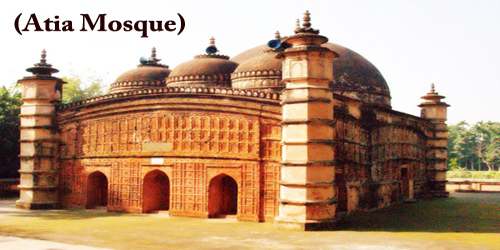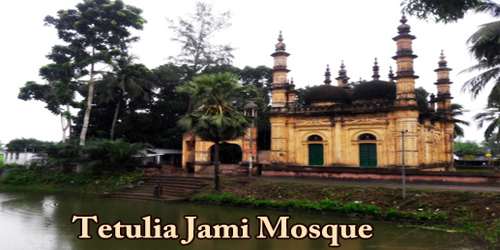Atia Mosque (Bengali: আতিয়া মসজিদ) is a 17th-century mosque, and it is situated in the village of Atiya under Delduar Upajilla in Tangail district, Bangladesh, about six kilometers south of the district headquarters. The mosque is also known as “Atia Jame Moshjid”, and it was built during the Mughal Empire. The mosque is situated on the east bank of the river Louhajang. The mosque is approximately 18 m by 12 m with 2.23 m thick walls, it has four spherical domes at the top, and one is the larger one, situated at the western part of the mosque. The other three are smaller in scale and situated on the mosque’s east side. All three dome’s in one row. Seems like the larger one is for the Imam, and also the other three are for Musalli (regular people). All the domes are decorated at the underside part and having a little minaret like object at the highest. The mosque has four pillars at the four corners and each of the pillars are stylish and decorated nicely. In line with an inscription (now preserved within the Bangladesh National Museum), the mosque was constructed between 1610 and 1611 during the reign of Emperor Jahangir by Sayeed Khan Panni, son of Baizid Khan Panni, in honor of Shah Baba Kashmiri. Shah Baba Kashmiri was a prominent Sufi saint of Bengal based during this area.
The mosque has lovely terracotta on the eastern outer side and the wall on the north side. With just a few small flowers inside the circles, these are very simple. The mosque has three easterly entrances, and two north and south entrances each. The main chamber of prayer is accessible through three smaller doors from the hallway. The mosque has four additional windows, two each on the north and south sides. There are three ornamented mihrabs on the qibla wall, the main one on the west side has an outward projection. The mosque’s central dome is borne on squinches, and the three are borne on pendentives over the east passage. During the massive 1800 Earthquake, the mosque was destroyed. A mosque rebuild was rendered in 1837. A further reconstruction made jointly by two Jamindar of Korotia and Delduar of Tangail during 1909. The curvilinear cornice, a distinctly indigenous characteristic of Bengal architecture, is the most striking of all the features of the mosque, the roots of which can fairly be traced to ordinary thatched huts with drooping eaves. In addition, the transformation of bamboo and chaff buildings into brick architecture is esthetically pleasing and structurally expedient here. The mosque combines pre-Mughal and Mughal elements. The photo of this iconic mosque accustomed to be printed on the Ten Taka note of Bangladesh. These notes are very scarce nowadays and are only available at banks or on only a few people’s collections now a day.
















